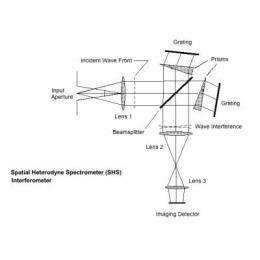NRL scientist receives patent for rugged-lightweight spectrometer assembly

Naval Research Laboratory (NRL) Space Science Division scientist, Dr. Christoph R. Englert, is awarded patent by the United States Patent and Trademark Office for a more cost effective, rugged and lightweight compression assembly design for spatial heterodyne spectrometer (SHS) interferometer applications. This innovative design approach introduces the flexibility of exchanging optical components while conserving the ruggedness of previous monolithic SHS interferometer designs and reducing their high production costs; a factor that has impeded wide-spread military and commercial application.
"This technique provides a faster, more flexible and more cost effective way to fabricate rugged SHS interferometers," said Englert. "By eliminating the labor and cost intensive practice of optical contacting—a method of bonding flat surfaces without the use of adhesives—production, assembly and material alignment can be simplified without compromising optical performance or durability."
Unlike the first monolithic SHS development led by NRL that used optical contacting to bond all the interferometer components into a single block, this method also allows greater design flexibility by providing the option of using various spacer materials (e.g., different glasses, metals, or combinations of materials), further optimizing application benefits.
SHS systems are compact in size, can be field widened to increase their throughput advantage, have no moving parts and can also be built in all-reflection configurations. Due to its compact size, ruggedness and sensitivity, SHS is especially well suited for high resolution, space- and ground-based spectroscopy of diffuse sources, including atmospheric emissions or trace gas absorptions.
Field-widened spatial heterodyne spectroscopy was conceived in the late 1980s by Fred Roesler, professor of astrophysics at University of Wisconsin and John Harlander, current professor of physics, astronomy and engineering science at St. Cloud State University, Minn. SHS interferometers typically include a beamsplitter, two gratings, and two field-widening prisms. The optical components of SHS interferometers must be mounted within precise tolerances to achieve high performance.
SHS technology has proven to be very successful in NRL's Spatial Heterodyne IMager for MEsospheric Radicals (SHIMMER), which is providing mesospheric hydroxyl concentration profiles and polar mesospheric cloud measurements from the NRL/STP satellite STPSat-1 to improve the understanding of the chemistry and dynamics of the middle atmosphere.
Source: Naval Research Laboratory (news : web)


















